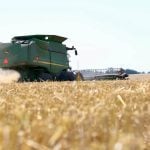It takes careful planning to properly place fertilizer with the seed.
Seed row placement of fertilizer provides advantages but it comes with risks.
Rigas Karamanos of fertilizer manufacturer Westco, based in Calgary, said producers should consider all factors that go into the safe use of seed- row-placed nutrients.
“Just because it worked last year doesn’t mean the combination of equipment, soil type and fertilizer product will deliver the same results this year,” said Karamanos, a crop nutrient researcher and agrologist.
Producers using single pass seeding systems have the challenge of placing enough fertilizer in the soil to take full advantage of the crop genetics and moisture that are available.
Read Also

VIDEO: Green Lightning and Nytro Ag win sustainability innovation award
Nytro Ag Corp and Green Lightning recieved an innovation award at Ag in Motion 2025 for the Green Lightning Nitrogen Machine, which converts atmospheric nitrogen into a plant-usable form.
Growers using side or mid-row banding systems can place more of the mobile fertilizer products in a manner that avoids toxicity and ensures easy access and optimal use by the crop.
While fall or early spring banding of urea, anhydrous ammonia, ammonium forms of nitrogen and sulfur in a sulfate form can be ideal, it requires additional field operations.
This may not be practical for growers working in a tight seeding window with many acres and limited labour or for those wanting minimum soil disturbance.
When it comes to phosphorus and potassium, which are less mobile elements needed for good crop nutrition, plants must reach reasonable levels of these nutrients shortly after germination.
Placing these elements as close to the seed as possible without causing damage requires looking at the whole agronomic situation in the field at the time of seeding, said Karamanos.
Ross McKenzie, of Alberta Agriculture and the University of Lethbridge, told producers attending a recent seminar held by the Canola Council of Canada and Reduced Tillage Linkages Alberta that they need to consider what the fertilizer is doing in the soil and with the plants as they make choices about what and how much to put in the seed row.
“Banded P isn’t going to be as effective as seed-placed P, but there are limits,” he said about the amount of phosphorus applied with seed.
Small seeded crops can be sensitive to phosphorus placement.
In wet or cool soils and where the levels are low, the effect of seed- row-placed phosphorus is maximized and its risk to plants minimized, said McKenzie.
He said seed row placement is also an effective way to apply small amounts of potassium, if it is required.
“Ideally, it is located within an inch to an inch and a half from the seed. It needs to be in the plant’s way as it grows,” he said.
McKenzie said 75 percent of the time on the Prairies, the seed placed phosphorus will outperform banded material “unless it is very dry at seeding.”
McKenzie and Karamanos say the main issue in deciding how much fertilizer to include in the seed row is soil moisture.
Dry soil usually means cutting by 50 percent the recommended amount of fertilizer that might be safely placed in the seed row.
However, revisiting the Westco research database on seed-row-placed nitrogen has provided specific recommendations for fertilizer under very dry soil and weather conditions, said Karamanos.
The two largest factors that limit fertilizer levels in the seed row are free ammonia and the effect of salts on newly germinated seeds.
The salt keeps young plants from accessing all of the available water immediately surrounding the newly germinated plants.
Chemical burning occurs when urea is converted to ammonium forms of nitrogen.
Ammonium sulfate sources don’t cause the same problem as ammonia, but do have a high salt index level.
Soils that have very high acidity and low cation exchange, or where there is little soil moisture, tend to create conditions that can dramatically increase the number of free ammonia ions and cause plant injury.
Fine textured soils, such as clay, have a high cation exchange capacity that ties up the ammonia, while at the same time retaining greater amounts of water that dilute fertilizer salt effect.
In some cases these heavy soils provide double the seedling safety of lighter textured dirt.
Cereals are more tolerant of seed row-placed fertilizer than oilseeds.
In provincially recommended safe rates for seed row-placed nitrogen, available on prairie government agriculture department websites, it is presumed that producers will be adding nitrogen to phosphate fertilizers that are also being seed row applied.
McKenzie said producers should examine seeding equipment to ensure that openers are not worn to the point where higher than recommended amounts of fertilizer are spread or where air pressure interferes with distribution.
He said excessive field travel and fan speeds compound the issue of getting seed and fertilizer in the right places, especially if rates are high enough that they require separation.
Growers can increase the amount of nitrogen they can safely place with the seed by using more of the available seedbed, said McKenzie.
He said producers can calculate this seed bed utilization (SBU) by dividing the width of the spread behind the seeding tool’s openers by the row spacing and multiplying by 100.
“Don’t guess. Go out and measure what your machine is doing in the field (behind the knife or shovel) before you look on the charts to see how much fertilizer you might apply,” said McKenzie.
“If you increase your SBU, you can safely increase the amount of (nitrogen). But if you don’t manage that SBU well in crops like canola that are more sensitive, it could cost you 20 percent of your yield pretty quickly.”
Both agrologists said other methods of nitrogen delivery might be required to maximize yields, but well managed seed row placement has a role for many producers.
“If you need higher rates, you should then be investing in a coated urea product or another method of delivery to the soil,” said Karamanos.














